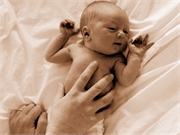Umbilical Cord 'Milking' Procedure Dangerous for Preemies: Study
By Steven ReinbergHealthDay Reporter

TUESDAY, Nov. 19, 2019 (HealthDay News) -- Squeezing the last drops of blood from the umbilical cord has been touted to help preterm babies get more of the nutrients they need, but it may be dangerous, a new study finds.
When umbilical cord blood is forced into the baby's abdomen, the pressure can cause tiny blood vessels in the brain to rupture. This is especially dangerous for the most preterm infants, the researchers said.
The study, funded by the U.S. National Institutes of Health, was stopped due to the heightened risk of internal bleeding.
In the study, researchers wanted to see if so-called "cord milking" was a good alternative to delayed cord clamping. Delayed clamping lets cord blood flow into the infant at a natural pace.
"Most doctors try delayed cord clamping when they can, and they occasionally will do the cord milking," said lead researcher Dr. Anup Katheria, a neonatologist at Sharp Mary Birch Hospital for Women and Newborns, in San Diego, Calif.
Babies who get cord blood aren't just getting blood, he said.
"These babies are getting stem cells and other cells that might help them develop a little bit better than babies that don't receive this extra blood," Katheria said. "They also get iron, which is a potent nutrient for brain development, and there's probably other things in the blood that might help these babies."
But, given these findings, he that said cord milking should be avoided in extremely preterm babies, those born at 23 to 27 weeks of pregnancy.
For the study, Katheria's team recruited women who were pregnant for less than 32 weeks and were at risk for preterm delivery. They were randomly assigned to umbilical cord milking or a 60-second delay in cord clamping.
The team had planned to enroll 1,500 infants (750 in each group). Because the study was cut short, only 474 babies were included, according to the report.
Among infants who had cord milking 12% died or developed severe brain bleeds, compared with 8% in the delayed-clamping group. The researchers said this difference wasn't statistically significant.
Neither was the death rate at 7% in the cord-milking group and 6% in the delayed-clamping group.
But the rate of severe brain bleeding was significantly higher among babies who had cord milking (8%) versus those who had delayed clamping (3%), the findings showed.
The greatest risk for severe brain bleeding was among infants born in the 23rd to 27th weeks of pregnancy, the study found. All 20 babies in the cord-milking group who suffered brain bleeds were born at this stage of pregnancy.
Among infants born at 28 to 32 weeks, none in the cord-milking group had bleeding, compared with three in the delayed-clamping group, which was not a significant difference, the researchers said.
Because the risk of brain bleeding was seen only in extremely preterm infants, Katheria's team is continuing to compare cord milking to delayed clamping in babies born at 30 to 32 weeks' gestation to see if either procedure will affect development as they grow. The infants will be evaluated at 2 years of age.
An earlier study of preemies delivered by cesarean section suggested that cord milking benefited preemies' brain development.
Dr. Saima Aftab is medical director of the Fetal Care Center at Nicklaus Children's Hospital in Miami. She said, "The current recommendation is that for preterm infants, delayed cord clamping is safe and should be done."
This study shows that cord milking isn't safe and "people should abandon that practice," Aftab added.
The report was published Nov. 19 in the Journal of the American Medical Association.
More information
For more about preterm infants, visit the March of Dimes.

The news stories provided in Health News and our Health-E News Newsletter are a service of the nationally syndicated HealthDay® news and information company. Stories refer to national trends and breaking health news, and are not necessarily indicative of or always supported by our facility and providers. This information is provided for informational and educational purposes only, and is not intended to be a substitute for medical advice, diagnosis, or treatment.

